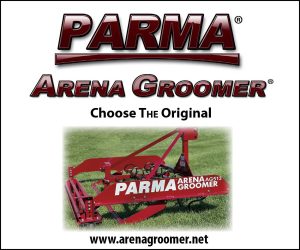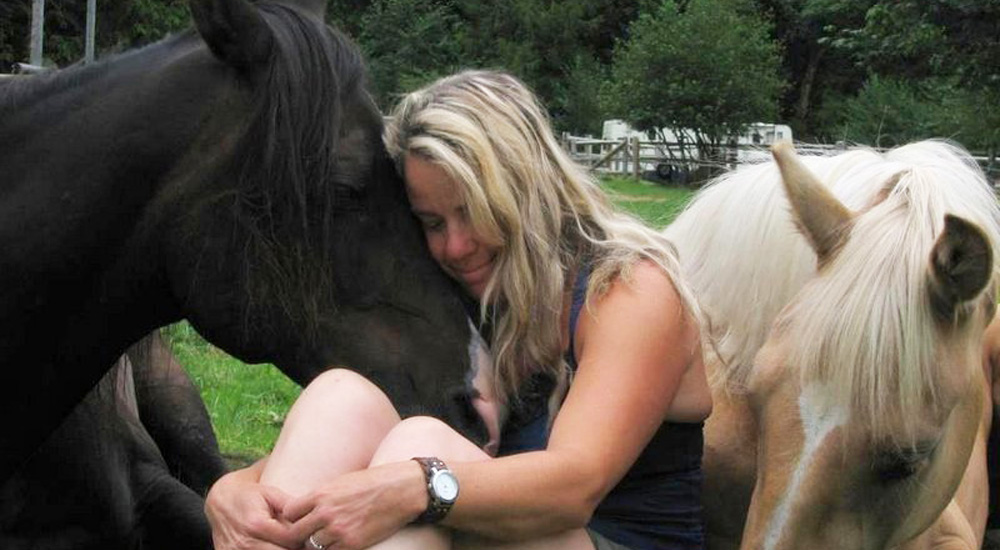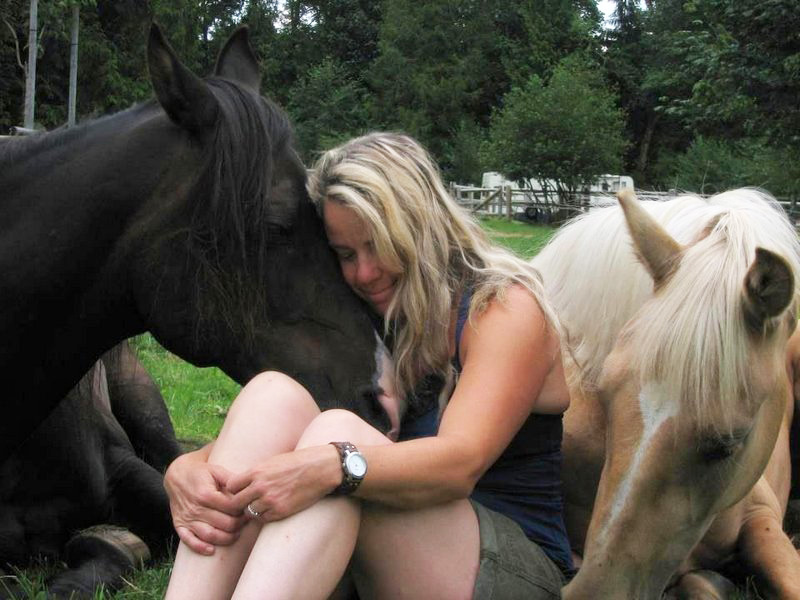~ Equine Structural Integration ~
Equine Structural Integration can help your horse to recover from new and old tension-based habits that inhibit their natural elegance and performance.
My intent is to bring the structure and alignment of the horse’s body into greater harmony with gravity, to allow a buoyancy and extension in every movement.
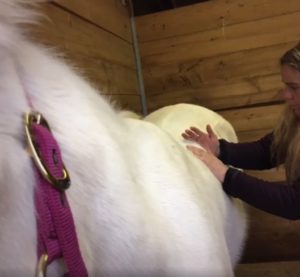 Structural Integration focuses not on the muscles but the connective tissue called fascia. Fascia surrounds muscles, groups of muscles, blood vessels, organs, bones, and nerves; binding some structures together while permitting others to slide smoothly over each other. Fascia is designed to be elastic and move freely with muscles and bones. Tightened fascia pulls the muscles and skeleton out of proper alignment, which can cause: pain, imbalanced movement, unwillingness to perform as requested, fatigue, anxiety, etc.
Structural Integration focuses not on the muscles but the connective tissue called fascia. Fascia surrounds muscles, groups of muscles, blood vessels, organs, bones, and nerves; binding some structures together while permitting others to slide smoothly over each other. Fascia is designed to be elastic and move freely with muscles and bones. Tightened fascia pulls the muscles and skeleton out of proper alignment, which can cause: pain, imbalanced movement, unwillingness to perform as requested, fatigue, anxiety, etc.
Structural Integration works to lengthen, stretch, and soften fascia to restore postural balance, extension and spring to movement. When body support is lacking, tissues and their related muscles compensate by shoring up specific areas in an effort to deal with these vulnerabilities. The body then becomes a negotiation of compensations and conflicting tensional strains. This natural response to imbalance and instability is also the body’s attempt to support itself against the ever-present forces of gravity. Structural Integration is designed to create sustainable change, going beyond merely treating the symptoms.
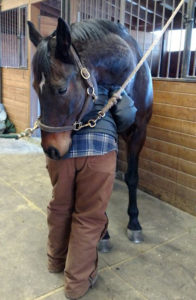 Equine Structural Integration (ESI) is a full body therapy. Even if an injury or fascial restriction is in a specific location, the entire body is affected because of the interconnectedness of the fascia. By working the entire body you are going to relieve existing compensations and catch others before they have a chance to take hold. So the work is not only rehabilitative and progressive, it’s also preventative. In addition to the physical benefits of this work, there is a positive influence on the energy body as well. “Acupuncture meridians flow through the fascial (connective tissue) planes of the body. When compression settles into the tissue, this also restricts energy flow along the meridian pathways, which can interfere with normal organ function. By releasing the compression along the meridian pathways this work can also have a dramatic effect on organ function.” -Allan Mutschler (graduate of the Guild for Structural Integration and founder of Connective Dynamics). The personality of the equine changes as well since pain will be lessened or gone completely, a much happier and more willing animal emerges.
Equine Structural Integration (ESI) is a full body therapy. Even if an injury or fascial restriction is in a specific location, the entire body is affected because of the interconnectedness of the fascia. By working the entire body you are going to relieve existing compensations and catch others before they have a chance to take hold. So the work is not only rehabilitative and progressive, it’s also preventative. In addition to the physical benefits of this work, there is a positive influence on the energy body as well. “Acupuncture meridians flow through the fascial (connective tissue) planes of the body. When compression settles into the tissue, this also restricts energy flow along the meridian pathways, which can interfere with normal organ function. By releasing the compression along the meridian pathways this work can also have a dramatic effect on organ function.” -Allan Mutschler (graduate of the Guild for Structural Integration and founder of Connective Dynamics). The personality of the equine changes as well since pain will be lessened or gone completely, a much happier and more willing animal emerges.
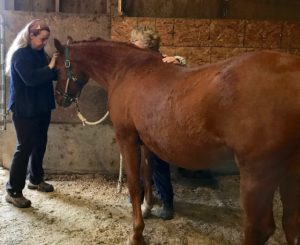 Movement is an event in which every segment of the body works in relationship to every other segment. If a body is overly stiff in certain places and flaccid in others, these relationships will be limited and the body will not be able to work as a balanced and flowing unit.
Movement is an event in which every segment of the body works in relationship to every other segment. If a body is overly stiff in certain places and flaccid in others, these relationships will be limited and the body will not be able to work as a balanced and flowing unit.
Structural Integration works hand in hand with many healing modalities. For example, chiropractic is more easily achieved when the fascial holdings are softer, the bones move with greater ease, adjustments last longer, and ESI work can help stop the tissues from pulling the bones out of alignment in the first place.
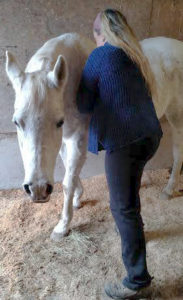 Ray McCall, a Certified Advanced ‘Rolfing’ Structural Integrationist, and a former student of Dr. Ida Rolf (the creator of Structural Integration) has said that: “What Structural Integrationists do can be summed up in three words: “palpation, discrimination and integration”. They ‘palpate’, or touch the tissue, feeling for imbalances in tissue texture, quality and temperature to determine where work is needed. They ‘discriminate’, or separate fascial layers that adhere and align bones and muscles that have been pulled out of position by strain or injury. Finally, they ‘integrate’ the body, relating its segments in an improved relationship, bringing greater physical balance within the gravitational field.”
Ray McCall, a Certified Advanced ‘Rolfing’ Structural Integrationist, and a former student of Dr. Ida Rolf (the creator of Structural Integration) has said that: “What Structural Integrationists do can be summed up in three words: “palpation, discrimination and integration”. They ‘palpate’, or touch the tissue, feeling for imbalances in tissue texture, quality and temperature to determine where work is needed. They ‘discriminate’, or separate fascial layers that adhere and align bones and muscles that have been pulled out of position by strain or injury. Finally, they ‘integrate’ the body, relating its segments in an improved relationship, bringing greater physical balance within the gravitational field.”
Other soft-tissue manipulation methods, including massage, are quite good at the first two, but do not balance the body in gravity. The true beauty of Equine Structural Integration is the art and science of reshaping and reorganizing the horse’s physical structure according to clearly defined principles in a systematic and consistent manner.
What is Fascia?
Fascia is the organ of form, the organ of stability.
Fascia has been given the general term of “connective tissue” but it is so much more than that. Fascia is the organ system of stability and mechanical regulation. Fascia is an interconnected net of fibers that may appear “fuzzy”, striated, and/or intricate connecting threads, like a spider web. Fascia allows change and movement beneath the skin, between the muscles, and anywhere anatomical structures have to slide on each other. There are ten times more sensory nerve endings in the fascia than in the muscles. Connective tissue includes blood, blood cells, & other elements that are not part of the structural net called fascia. The more definitive term for fascia may be extra-cellular matrix (ECM). The ECM is mostly comprised of fibers, glue, and water.
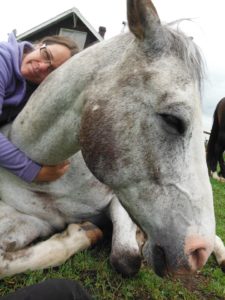 Most ESI treatments fit into the category of ‘performance enhancement’ and the results often are stunning as you see what the horse truly is capable of. In ‘rehabilitation’ situations the goal is to bring the horse to a stable, balanced place and help the animal stay there; and in some cases, progress from there.
Most ESI treatments fit into the category of ‘performance enhancement’ and the results often are stunning as you see what the horse truly is capable of. In ‘rehabilitation’ situations the goal is to bring the horse to a stable, balanced place and help the animal stay there; and in some cases, progress from there.
“A horse’s true personality can be dampened by pain. After a session the horse may become feisty, playful, and even powerful. Holdings take energy from the horse. Release of these holdings returns his precious stored energy and a new awareness of himself that the horse needs to thrive.” Joseph Freeman, (creator of the Equine Natural Movement School)
Equine Structural Integration can help your horse to recover from new and old tension-based habits that inhibit their natural elegance and performance.
Learn more, see rates and read testimonials:
www.cascadesherpas.com/equine-structural-integration/

The Northwest Horse Source is an independently owned and operated print and online magazine for horse owners and enthusiasts of all breeds and disciplines in the Pacific Northwest. Our contemporary editorial columns are predominantly written by experts in the region, covering the care, training, keeping and enjoyment of horses, with an eye to the specific concerns in our region.




